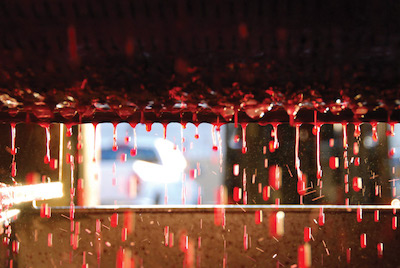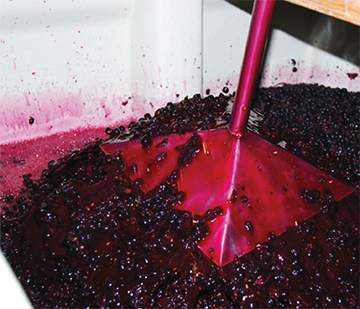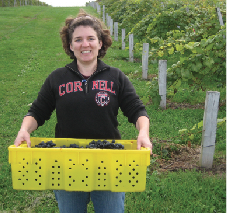 Oxygen’s presence or absence at the various stages of winemaking can have extraordinarily important and lasting effects on what our wines taste like. Too much and you risk oxidation damage, too little and you risk reduction stink. The effects of oxygen on wine, much more so with red wines, may be the most complex and least understood part of the winemaking process (once the grapes have left the vine) —we know a lot, but we have not solved the mystery of oxygen and wine.
Oxygen’s presence or absence at the various stages of winemaking can have extraordinarily important and lasting effects on what our wines taste like. Too much and you risk oxidation damage, too little and you risk reduction stink. The effects of oxygen on wine, much more so with red wines, may be the most complex and least understood part of the winemaking process (once the grapes have left the vine) —we know a lot, but we have not solved the mystery of oxygen and wine.
One note before beginning: Perhaps the most important thing I can say regarding oxygen is to always keep your carboys and tanks as full as possible. For carboys, no more than 1⁄8 inch of air space at all times. Add sanitized marbles if needed. Judging home winemaking competitions, the most common defect I’ve come across is oxidation. Most home winemakers are particularly “at risk” for oxidation damage, as the smaller volumes of wine generally react much faster to oxygen exposure than the larger volumes of commercial wineries.
Let’s discuss whites and reds separately, as their handling and needs are so different. With white wines there are three critical points to decide whether or not to expose the must or wine to oxygen: After pressing/before fermentation, during fermentation, and during aging. This first point can involve lots of oxygen, the second two are essentially the choice between oak (or another oxygen-permeable aging/fermenting vessel) or stainless steel/carboys (or another non-permeable vessel), and thus much smaller amounts of oxygen.
The decision at the time of pressing with regard to oxygen is to protect your must with inert gas, or to expose it, and, if exposing, to what extent. Protecting your white must from oxygen has been the most common modern practice, and doing so is thought to protect the more delicate aromas in the must. Browning a must before fermentation will oxidize various phenols (that will precipitate out during fermentation), which might otherwise oxidize prematurely in bottle — the idea being that this early exposure to oxygen, and precipitation of these phenols, can extend a wine’s life in bottle, and allow more time for tertiary aromatics to develop. During fermentation, a brown must will quickly become clear again, as the oxidized compounds precipitate out.
For my Chardonnay, a grape which prior to fermentation does not have an abundance of delicate aromas, and one which I intend for aging, I brown. The Albariño I will make this year, whose must will be filled with delicate floral aromas, and which I expect to be aged less time than the Chardonnay (though great Albariños age wonderfully), I will be more protective with prior to fermentation. Whether or not to expose a must to oxygen, and to what degree, has been one part of a major white winemaking debate over the last two decades on “premox”, or, premature oxidation.
If choosing to protect your wine, the addition of sulfur dioxide helps discourage oxidation of phenolics by blocking enzymatic action, but sulfur dioxide’s use prior to fermentation is primarily for protection from unwanted microbiota. Real protection means keeping oxygen away, and the use of inert gas is necessary. Gas your press pan before it catches your must and gas and cover your fermentation vessels (prior to fermentation’s start) with inert gas. An argon or nitrogen tank can be found for around $100.00 online. For a budget version, a few chunks of dry ice in the press pan or fermentation vessels not only looks cool, but adds a visible blanket over your must. Dry ice gets expensive, so a tank may be a better investment in the long run. Using carbon dioxide for protection is only recommended prior to fermentation, as finished and aging wine will quickly absorb it, and you should aim to have all the carbon dioxide out of your wine prior to bottling, unless you would like it to have a spritz. Once fermentation starts, the carbon dioxide produced will protect the surface of the wine, and the fermenting wine itself, from oxygen.
Perhaps the most important thing I can say regarding oxygen is to always keep your carboys and tanks as full as possible.
If you’d like to brown, it’s a lot simpler: Skip or go low on sulfur dioxide and don’t fret about oxygen contact. You can splash your must around a bit or wait as many as a few days to inoculate, as long as the must is protected from bugs (I’ve heard stories that Ceritas, who produces some of the most sought after Chardonnays in California, exposes Chardonnay must to the point that a bit of mold develops before allowing fermentation to start!). Everything that turns brown will precipitate out during fermentation, and therefore isn’t a threat later in bottle.
Sufficient oxygen during fermentation, while not necessary for fermentation to start and complete, is essential to a happy and healthy one. Most white fermentations can go to completion without the need for adding more air, but, particularly if you have protected from oxygen during pressing, or are fermenting in a non-porous vessel, keep an eye out for the funky, hard, metallic scent of hydrogen sulfide. Especially if caught early, splash racking to oxidize out the hydrogen sulfide should help reduce or eliminate it, preferably before fermentation starts to slow, as the fermenting wine will be more than saturated with carbon dioxide, there is minimal risk of oxidation. It is important to note here that these off odors can also arise from fermentation issues unrelated to oxygen. Low YAN (yeast assimilable nitrogen) for yeast to consume can stress yeast, causing off odors. If you cannot check YAN and wish to play it safe, adding nutrients at the start of fermentation can help avoid this (though be judicious, nutrients not consumed during fermentation can cause their own odors and feed Brettanomyces!). Another possible origin of hydrogen sulfide is yeast strain: Strains, such as Montrachet, are known for producing higher levels of hydrogen sulfide, while others, such as Prise de Mousse/Premier Cuvée, or my favorite DV10, are very low producers.

The choice of whether or not to ferment and/or age your wine in a non-porous vessel, such as a glass carboy or stainless tank, versus a porous one like an oak barrel, or certain plastics (including most buckets) is, of course, one of style. For fermentation, the yeast will welcome the extra air of a porous vessel. Beyond imparting some oak character, the air that oak barrels allow to your fermenting must or aging wine will help round it out and give it a fuller mouthfeel, but you may lose a degree of aromatic vibrancy. Use of non-porous vessels will maintain a higher degree of freshness, and perhaps aromatic precision. The resulting wine will remain more youthful, austere, and linear.
Of course, with whites being especially sensitive to oxidation (as you’ll see, they do not have the use for oxygen that reds do), it is especially important after fermentation to be gentle with your wine and avoid excessive exposure to oxygen. Maintain carboys with no more than 1⁄8 th inch of air space; when racking, always submerge the end of your racking hose into the freshly racked wine rather than splash racking against the receiving vessel’s wall, and always keep your wine sufficiently cool (wine absorbs exponentially less oxygen in cooler temperatures than in warmer ones). As far as treating a wine gently, I’m always happy when I see just a bit of residual carbon dioxide when racking a white prior to bottling, as I know it has had some extra protection.
If you begin to get a bit of a oxidative Sherry aroma during aging, which smells like an apple slice left out too long, (this is acetaldehyde, formed by an enzymatic reaction between oxygen and ethanol), a touch of sulfur dioxide can clean it right up by binding to the acetaldehyde and rendering it non-volatile. This is the reason that when bottling my Sherries, where acetaldehyde is such an important and desired component, I do not use any sulfur dioxide, as it would take away from what’s taken years to develop.
You have the similar oxygen risks with reds as with whites (too little oxygen — reduction, too much — oxidation); however the quantities of oxygen involved for both of these situations are significantly greater than with whites. Red wines react very differently to oxygen than do whites; protecting a white from air from start to finish is a solid strategy, while doing so with a red can have adverse effects.
During fermentation, the oxygen you provide by punching down or pumping over will be more than enough to keep the yeast happy. Once crushed, red grapes begin to release a dizzying diversity of phenolic compounds into the must. Of utmost importance and abundance are monomeric anthocyanins (color) and monomeric tannin (and tannin building blocks). Monomeric molecules are individual molecules, not bound to any other. Color extraction peaks after a few days into fermentation, and tannin extraction starts slowly and continues to increase in pace as alcohol is created and helps it to extract.
In the absence of oxygen, tannins can bind with many things, including other tannins. Long chains of tannins are unstable and can lead to an unpleasant drying sensation in the mouth. Color can be absorbed by lees in the wine, bleached by sulfur dioxide (although this is reversible over time) and destroyed by various enzymes. Aside from the aesthetic benefits of these compounds, which are greatly diminished when they are not bound together, they precipitate out of a wine much faster, shortening its life significantly. So, it is important we get them together fast. The process of binding various monomers is called polymerization, and a group of polymerized monomers is known as a polymer.
To have stable color and tannin, and a longer life for your wine, we need to facilitate their polymerization with one another in the presence of oxygen. The presence of oxygen is thought to facilitate their polymerization, and does so faster and in a way that tastes better and lasts longer. Some studies show that this may not be the case 100% of the time. The process by which they polymerize in the presence of oxygen is called the Vicinal Diphenol Cascade, which was discovered by Dr. Vernon Singleton. It begins to explain some of the mysteries around red wine structure, including how under the right circumstances (tannin-to-color ratio, timing and amount of oxygen, and other factors), oxygen can actually cause a structured red wine to reduce, rather than to open up! For some insight into this, and many more thought provoking wine concepts, I encourage everybody to read Clark Smith’s inspiring Postmodern Winemaking. I’ll leave those rabbit holes for future articles, and stick with a more practical outline here!
At pressing, a wine is both saturated with carbon dioxide (and therefore lacking oxygen) and at its height of having available color and tannin molecules. It isn’t uncommon for a wine just pressed, particularly the press run, to be a bit reduced, so a nice saturation of oxygen is advisable here, both to facilitate oxidative polymerization of color and tannin, and ward off any unwanted reduction. The act of pressing itself should aerate the wine some on its own, particularly if using an upright basket press.
While aging a wine, the amount of air you give it will be an important factor determining how “open” (being more demonstrative of its fruit and aromas) or “closed” (not showing off its aromas, often smelling somewhat reduced) it will be. More colored and tannic wines may require more air to keep reduction at bay and bring about openness; lighter, less structured wines will require much less.
After pressing, racking is where the wine will receive the majority of its air during aging. Some winemakers choose only to rack once, off the gross lees, and not again until bottling. This will likely lead to some degree of reduction. Reduction, as long as it is not excessive and leading to mercaptans, is not necessarily a problem. Although it may require many years in bottle to slowly dissipate, in a highly structured wine it may allow for more graceful aging, as it slowly develops and reveals itself. Prior to Robert Parker’s influence, most Bordeaux wines began their lives highly reductive, and could take decades to come around. This, however, requires a lot of patience and faith! Other winemakers choose to rack more frequently, and aren’t afraid of oxygen. Doing so will result in a wine’s being open, softer, and ready to drink sooner.
Over the first year of a wine’s life, the pool of available color and tannin diminishes greatly, as they polymerize and are lost to precipitation and lees. By the one year point, little is left, and a wine can absorb only a fraction of the oxygen it was able to at the time of pressing without being damaged (that being said, most structured red wines are happy for a racking before bottling, especially if they’ve seen few leading up to it.)
So you can see how different the factors involving oxygen can be between whites and reds. With whites, it is much more cut and dry, and with reds, we’re just now beginning to get some insight into their complicated hidden life.





